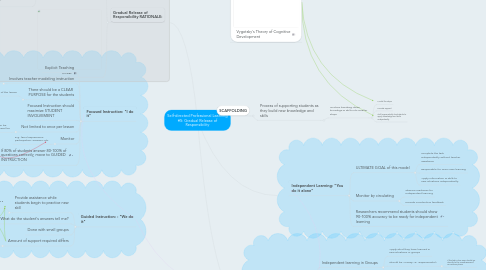
1. OCT Expectation: understanding and using scaffolded instruction to meet the assessed needs of all learners through the gradual release of responsibility
2. Focused Instruction: "I do it"
2.1. Explicit Teaching
2.2. Involves teacher modeling instruction
2.2.1. "Think-Alouds"
2.3. There should be a CLEAR PURPOSE for the students
2.3.1. explains the relevance of the lesson
2.4. Focused Instruction should maximize STUDENT INVOLVEMENT
2.5. Not limited to once per lesson
2.5.1. Focused instruction can be done several times if need be
2.6. Monitor
2.6.1. E.g. facial expressions, participation, answers, etc.
2.7. If 80% of students answer 80-100% of questions correctly, move to GUIDED INSTRUCTION
3. Guided Instruction: : "We do it"
3.1. Provide assistance while students begin to practice new skill
3.1.1. At first, the teacher provides a lot of support
3.1.1.1. Gradually withdraw support as students become more comfortable
3.2. "What do the student's answers tell me?
3.3. Done with small groups
3.4. Amount of support required differs
3.4.1. Ideal time to DIFFERENTIATE learning to meet the needs of students
4. Gradual Release of Responsibility RATIONALE:
4.1. Teaching Channel: Improving Practice with Sarah Brown Wessling
4.1.1. "The cognitive load of what we do has to shift to the learner."
4.1.2. This framework is not about CHANGING students, but MEETING them where they are
4.1.3. A way of getting students to be individual thinkers
4.1.3.1. Not a method of delivery content
4.1.4. As more responsibility is passed onto the student, they gradually construct and own the knowledge
4.2. MODEL
5. Collaborative Learning: "You Do it Together
5.1. Independent learning in Groups
5.1.1. Apply what they have learned in new situations in groups
5.1.2. Should be "messy" & "experimental"
5.1.2.1. If the task is too easy, should go directly to the INDEPENDENT LEARNING phase
5.1.3. Should allow for independent accountability within the groups
5.1.3.1. E.G. numbered heads, individual jobs/responses
5.2. Way to consolidate thinking and understanding in groups
5.3. This important stage is often omitted or neglected
5.4. Monitor by circulating
5.4.1. Observe accuracy of understanding
5.4.2. provide constructive feedback
5.4.3. provide appropriate prompts and questions to assist students
6. Independent Learning: "You do it alone"
6.1. ULTIMATE GOAL of this model
6.1.1. complete the task independently without teacher assistance
6.1.2. Responsible for one's own learning
6.1.3. Apply information & skills to new situations independently
6.2. Monitor by circulating
6.2.1. observe readiness for independent learning
6.2.2. Provide constructive feedback
6.3. Researchers recommend students should show 90-100% accuracy to be ready for independent learning
7. SCAFFOLDING
7.1. Process of supporting students as they build new knowledge and skills
7.1.1. involves breaking down knowlege & skills into smaller steps
7.1.1.1. Model the steps
7.1.1.2. Provide support
7.1.1.3. Shift responsibility to students to apply knowledge and skills indepedently
